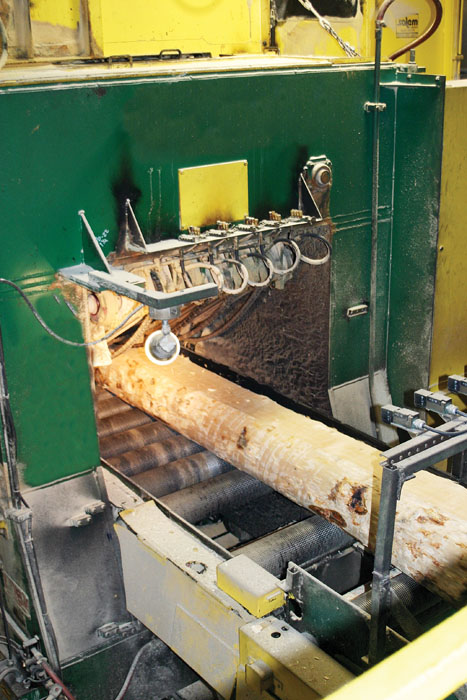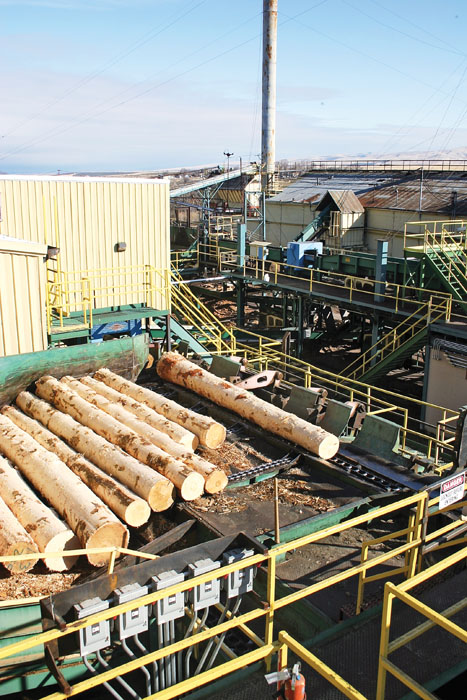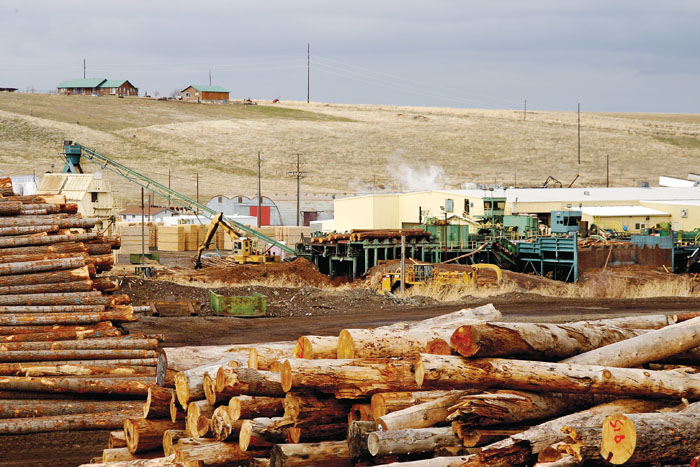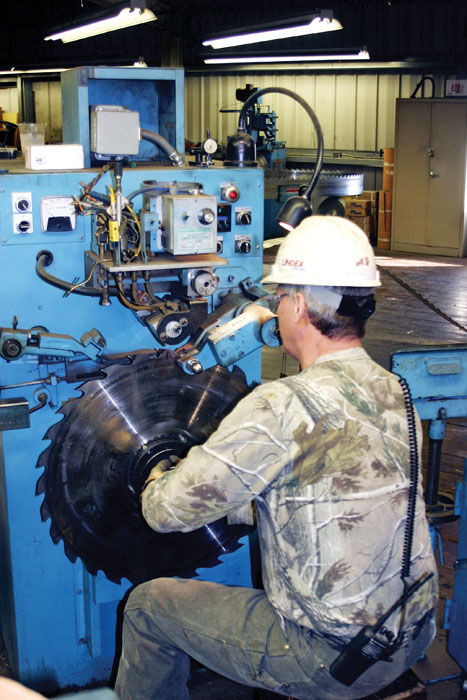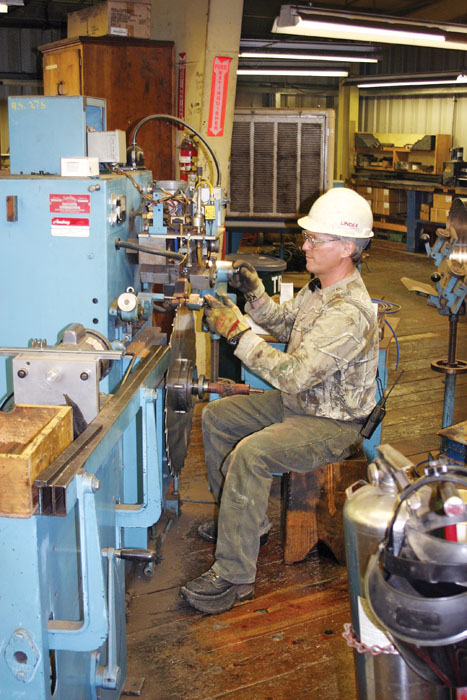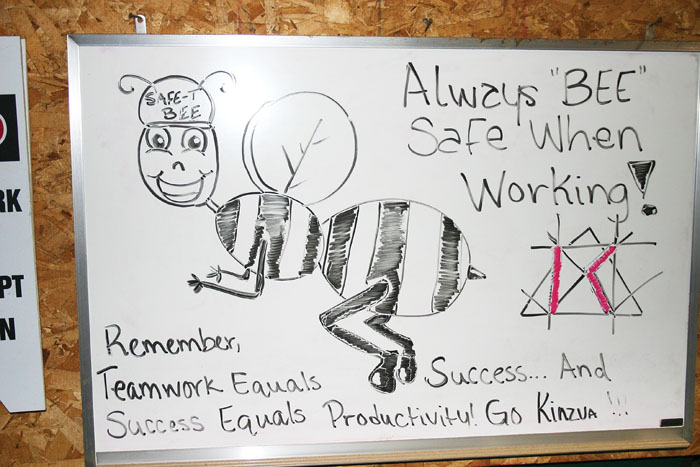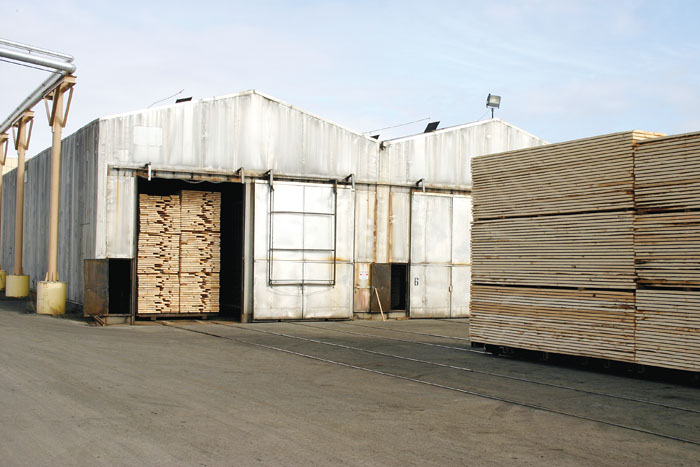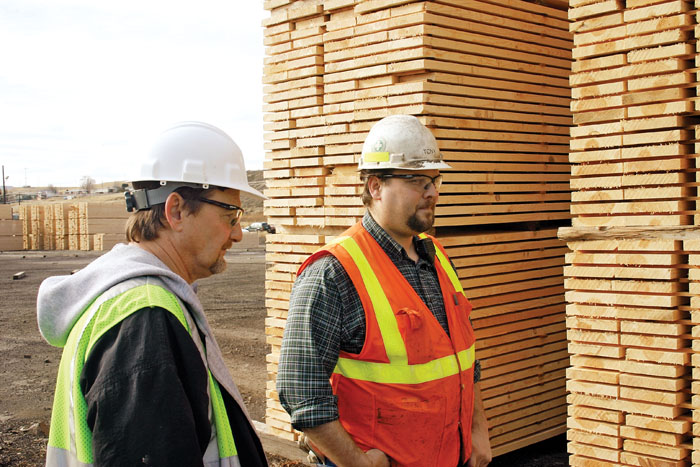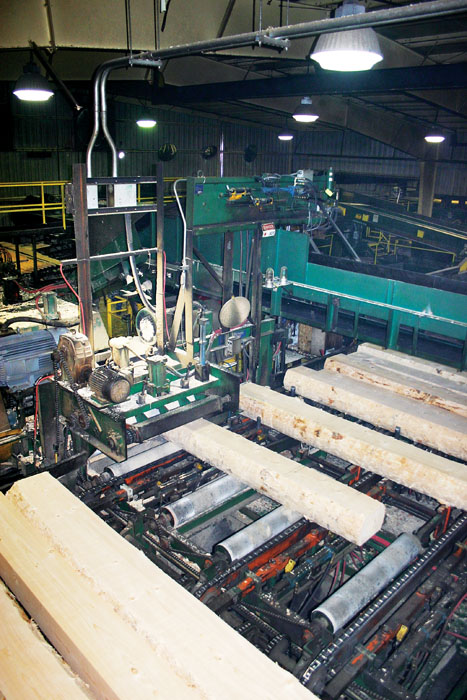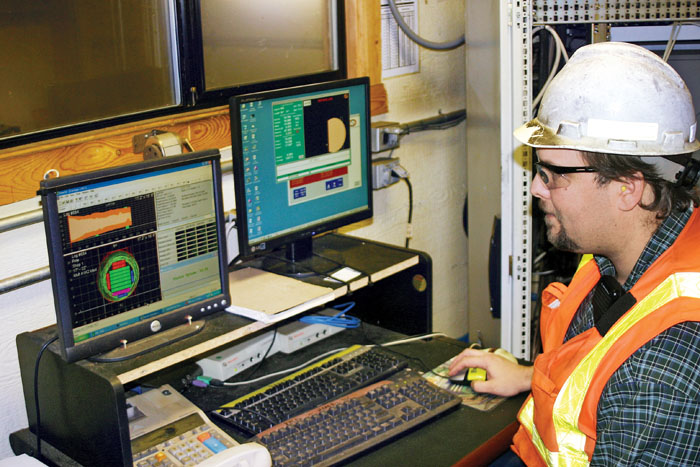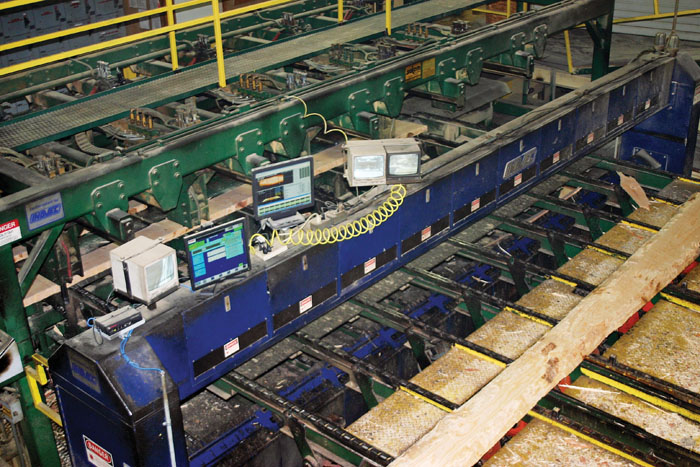Boise Kinzua Sawmill
PILOT ROCK, Ore. – When it acquired the northeast Oregon mill here three years ago, Boise Cascade LLC sought to avoid the impression of big corporate culture “taking over” the facility, says Plant Superintendent Mike Zojonc. “There had always been a very ‘can-do’ attitude at this mill. Boise Cascade came in looking at anything that could be changed or improved, with the idea of keeping the best, and improving the rest.’”
Now in its eighth decade of operations under a series of owners, Boise Cascade’s sawmill here, operating as Kinzua Lumber, has greatly benefited from its new ownership in terms of log supply, organizational resources and clarity of goals and objectives as part of an integrated forest products company as opposed to being a stand-alone sawmill.
A longtime fixture in eastern Oregon, the sawmill was built and started up in 1940 as Pilot Rock Lumber Co., operating as such until Georgia Pacific bought the mill in 1962. In 1972 the facility was purchased by Louisiana-Pacific, which operated it until 1996 and then sold it to Frontier Resources. Frontier changed the mill’s name to Kinzua Resources, operated the mill for more than a decade and sold it to Boise Cascade in 2009.
While Frontier Resources struggled to keep enough logs for the mill and tried its hand in a variety of markets, the Pilot Rock facility fit well with Boise Cascade’s integrated approach and new timber procurement dynamics after selling most of its land in the region to Forest Capital Partners LLC.
The Pilot Rock mill provides a good high-value solution for Boise’s pine lumber production, and residuals from the sawmill feed the Boise Cascade LLC LaGrande, Ore. particleboard plant. Currently, chips are sent to the Boise Inc. paper plant at Wallula, Wash. (Boise Cascade LLC and Boise Inc. are two distinctly different companies.) The Pilot Rock facility provides a sawing destination for large logs, while ponderosa pine under 12 in. goes to the Boise Cascade LLC Mt. Emily sawmill in LaGrande.
Another key development with the new ownership has been a closer coordination with the sales force and a larger number of customers. The mill’s industrial pine products are used by major door and window manufacturers, and Boise Cascade has long-term relationships with many of them.
“We have a larger customer base now, and we’re doing more order-based work with the sales group,” Zojonc says, adding that Boise’s sales group develops a monthly forecast, and the mill roughly follows it as a production guide. To bolster the effort on customer service, on-time shipping has also seen a big improvement since the ownership change, coming in at 100% on time this past January.
New Owners
One of the biggest changes is in safety—long a hallmark of Boise Cascade operations. Many safety meetings involve all employees, Zojonc says. “The response from employees on the safety issue has been great,” he adds. “Before, it was all production. Now, they know to think before they act.”
As the emphasis on safety became more fully implemented, the number of reported incidents rose a bit as the injury rate dropped the past few years. “That’s to be expected, because we emphasize the importance of reporting close calls and near misses so we can fix any problems,” Zojonc says. “We thoroughly investigate the root causes and correct them.”
Changes on the safety front include extensive training of new hires through supervisors and experienced crew members. “The lead people play a big role here,” says Jim Berry, human resources coordinator for the facility. “Our people have helped all along with safety, making changes to operations, and the employees really have taken ownership of the program.”
Facilitating changes at the mill are key employees, among them Rick Isaacson, Production Manager; Shawna Kirk, Accountant; Kassie Stern, Admin Tech; Mark Contreras, General Operations Supervisor; Greg Rice, Planer Lead; Robert Schonert III, Kiln Assistant Lead; Tom Moore, Maintenance Supterintendent; Dorian Denton, Head Diesel Mechanic; David Hoeft, Lead Millwright; Kirby Pete, Head Electrician; David Hinkle, Head Filer; Tony Nolan, Sawmill Supervisor; Marvin Springer, Sawmill Lead; Bill McLaren, Log Yard Lead; and Tony McKague, Log Buyer.
Boise also brought with its ownership a dedication to “green” operations and has been working with Cascade Energy Engineering to find ways to conserve energy and reduce consumption. “Being environmentally responsible is part of the Boise way and a core value,” Zojonc says, noting small things like battery and lightbulb recycling, the creation of a universal waste recycling program and also bigger projects such as changing storm flow destination to eliminate storm runoff water into Birch Creek, which bisects the plant and is a salmon- and steelhead-bearing stream.
Boise Cascade is committed to ensuring proper water quality through effective monitoring and control of runoff through elimination of outfall to the stream. Since making changes to the storm water handling system in mid 2010, the plant has not discharged storm water to Birch Creek, and those changes have positively influenced the creek’s water quality.
Mill Changes
One of the first things Boise did after buying the mill was change its focus from multiple species to one: pine. In doing so, the mill’s small log processing line was shut down, leaving the grade-sawing large side and downstream equipment in place.
At the headrig, improvements were made to upgrade the machine’s USNR scanning system and optimization software. “The focus now is to give the sawyer the highest value solution, whether that’s in grade or fiber recovery,” says sawmill supervisor Tony Nolan. “We’ve seen significant improvements there.”
Kinzua Lumber’s horizontal resaw received a new scanning and optimization package by MPM Engineering, including a new light curtain scanning system, new software, controls and PLCs. At the board edger, the mill kept the scanning system but upgraded its USNR optimization package to the company’s new MillExpert software. The job included new setworks, and the four-day project was completed in three. “They (USNR) did a real good job,” Nolan says, “and we gained reliability, accuracy and more fiber recovery.”
On the dry end, the mill added new kiln coatings, upgraded drying controls and programs at the kilns through a consultant, and incorporated knowledge gained from Oregon State University’s “kiln school.”
The dry kiln changes reflect the mill’s new focus on higher-grade pine products and the care taken to manufacture them, Zojonc says. “We’re doing more equalization and conditioning with cool-down periods in between,” he adds. “We’re getting higher quality lumber and not wasting wood like in the past.”
The planer mill also received an upgrade, with new planer setworks from USNR on the mill’s Newman 990 planer, plus a new overhead tensioning and positioning system from Cobra Technical Services. The planer project also included a PLC upgrade to all new Allen-Bradley Control Logix PLCs.
Mill Flow
The mill processes all pine, with some red and white fir coming into its log yard that’s routed to Boise’s Elgin, Ore. plywood/stud mill. A whole log chipper on site allows for pulpwood processing, with chips sent to Boise Inc.’s Wallula, Wash. paper mill.
The Pilot Rock mill can handle logs from 12 in. to 60 in. Average log diameter is 14-15 in. small end. Logs are sorted more by grade and species than size. A new Deere 988H handles log truck unloading. A LeTourneau log handler and Cat 988 move logs while a Cat 330 handles decking duties and a Cat 235 feeds the chipper.
Logs are first fed through a Nicholson A5 35 in. debarker and on to an 84 in. swing arm cutoff saw. Logs larger than 35 in. are pre-debarked using a Salem 42 in. debarker, then staged to the mill in a process that maintains optimum efficiency of operation. Stems are cut to 16 ft. maximum length. Logs then flow to the 17° slanted Salem bandmill and carriage with upgraded scanning and optimization.
Small logs may receive a single pass at the headrig, while some larger logs are grade sawn. “We did some 4/4 before, but now we’re strictly 5/4 and 6/4,” Nolan says, adding that the mill does cut some proprietary grades for key customers. “We’re getting a lot more out of the log now, and our #2 and better recovery is up more than 10% over last year.” Cant size at the headrig depends on grade, but generally ranges from 6-12 in.
Doubles and triples are routed to the Salem twin band horizontal resaw. Cants are sent to the USNR double-arbor, double saw bank gang edger featuring pre-positioning table with laser lines and chipping heads prior to the sawbox. The two saw banks provide flexibility, with 10-12 in. cants going to one side and into 6/4 products, while 6-8 in. cants go to another bank that’s set up for 5/4.
The mill’s round saws are stainless steel blades from California Saw & Knife running Stellite tips. Band saws are from Simonds. Knives at the headrig’s chipping head are from Key Knife; the mill runs the Lindsay Lindex knife system at the gang’s chipping heads.
The USNR trimmer includes Inovec-USNR Trim Master scanning package with Lucidyne controls. Downstream of the trimmer, boards flow to an LSI stacker and 40 bin LSI sorter.
The mill operates seven kilns: three 72 ft. Wellons units and four 100 ft. LSI kilns. The kilns are heated by a natural gas-fired boiler that the mill switched to recently thanks to low natural gas prices.
“We’re doing an overall better job with the kilns,” says Zojonc, citing a new stickering pattern on lumber charges along with “lots of process and quality changes.” Taking care with the high-quality pine products, kiln times may range up to 125 hours for 6/4 lumber. “We dry based on customer needs, and some want a lower moisture content,” Zojonc says, adding that for some customers the mill is testing for stress relief within the boards.
At the planer mill, boards are processed through a Newman 990 planer with significant upgrades, then flow to an Irvington-Moore trimmer. Downstream from the trimmer, all boards are hand-pulled.
Image Gallery
Latest News
Sierra Pacific Plants 300 Millionth Seedling
Sierra Pacific Plants 300 Millionth SeedlingSierra Pacific Industries reported the planting of its...
Fulghum Commissions 170 ft. Crane In Arkansas
Fulghum Commissions 170 ft. Crane In ArkansasFulghum Industries, Inc. is pleased to announce the...
Auburn University Announces Agenda For CLT Conference
Auburn University Announces Agenda For CLT ConferenceThe Auburn University College of Forestry,...
Besse Forest Products Closes Three Veneer, Lumber Operations
Besse Forest Products Closes Three Veneer, Lumber OperationsOfficials with Michigan-based Besse...
West Salem Unveils New Website
West Salem Machinery (WSM) has announced the launch of its newly redesigned website, www.westsalem.com, aimed at modernizing the user interface and making valuable information more intuitive and accessible.
Weyerhaeuser Continues THRIVE Program
Weyerhaeuser Continues THRIVE ProgramWeyerhaeuser has announced a commitment to invest $1 million...
Two More Oregon Mills Go Down: Malheur, W. Cascade Closures
Two More Oregon Mills Go Down: Malheur, W. Cascade ClosuresTwo more Oregon sawmill operations have...
NHLA Receives Second Grant From Forest Service
National Hardwood Lumber Assn. (NHLA) is proud to announce that it has beenawarded its second $500,000 matching grant from the USDA Forest Service Wood Innovations Program.
Canfor Announces Transition; Yurkovich Becomes CEO
John Baird, Chairman of the Canfor Corp. Board of Directors, announced today that Don Kayne, President and Chief Executive Officer, plans to retire at the end of the year.
AWC Will Receive $6 Million Grant
AWC Will Receive $6 Million Grant American Wood Council (AWC) has been selected for a $6 million...
Find Us On Social
Newsletter
The monthly Timber Processing Industry Newsletter reaches over 4,000 mill owners and supervisors.
Subscribe/Renew
Timber Processing is delivered 10 times per year to subscribers who represent sawmill ownership, management and supervisory personnel and corporate executives. Subscriptions are FREE to qualified individuals.
Advertise
Complete the online form so we can direct you to the appropriate Sales Representative.

